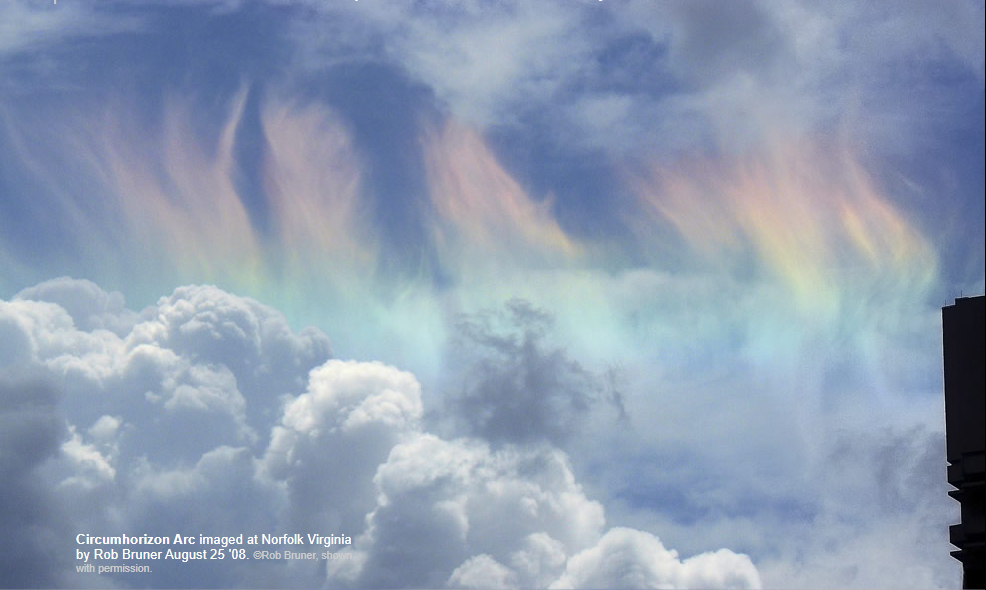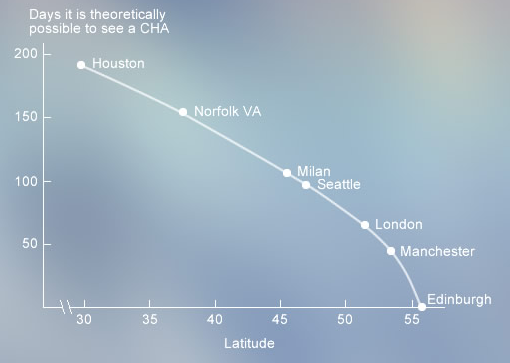Is the CHA rare?
Is the Circumhorizon Arc Rare?
When it comes to atmospheric optics, one phenomenon that often captures our imagination is the circumhorizon arc (CHA). This stunning display of vibrant colors can be seen spreading beneath the summer sun, creating a breathtaking spectacle in the sky. While it is often referred to as a rare occurrence, the rarity of witnessing a circumhorizon arc depends on various factors, including geographical location and the height of the sun.
To understand why the circumhorizon arc is considered rare, we need to delve into its formation process. The sun must be positioned higher than 58 degrees in the sky for a circumhorizon arc to form. If the sun is any lower, the rays that would contribute to the arc are internally reflected within the lower face of the plate crystals, resulting in their brightness being added to the parhelic circle instead.
Geographical location plays a crucial role in determining the frequency at which one can witness a circumhorizon arc. For instance, cities like Manchester in northern England have only around 45 days during midsummer when the sun reaches a sufficient height to make it possible to observe this optical phenomenon. However, this is contingent upon favorable weather conditions and the presence of cirrus clouds. Therefore, Mancunians will readily admit that these qualifications pose significant challenges to spotting a circumhorizon arc.
In contrast, some locations offer more opportunities to witness this awe-inspiring display. For example, Norfolk, Virginia boasts approximately 155 days when the sun is high enough to create a circumhorizon arc. Similarly, Houston, Texas experiences an even greater number of days, with around 192 instances where the sun reaches the necessary height for this optical phenomenon to occur.
While the circumhorizon arc may not be considered rare in certain parts of the United States, it remains an exquisite sight nonetheless. Its vibrant colors and expansive nature continue to captivate observers, regardless of how frequently it may appear in the sky.
In conclusion, the rarity of the circumhorizon arc is subjective and heavily influenced by geographical location and the position of the sun. While some places may have limited opportunities to witness this phenomenon, others are fortunate enough to experience it more frequently. Regardless of its rarity, the circumhorizon arc continues to inspire awe and wonder in those fortunate enough to witness its splendor. So, keep your eyes on the sky and you may just be rewarded with a breathtaking display of colors that will leave you in awe of nature's wonders.

Circumhorizon Arc imaged at Norfolk Virginia by Rob Bruner August 25 '08. ©Rob Bruner, shown with permission.
Circumhorizon arcs spread huge and colourful beneath the summer sun.
They are often said to be rare. But that depends, among other things, on where you are.
The sun must be higher than 58� to form it, any lower and the rays that would have contributed are internally reflected inside the lower face of the plate crystals and add their brightness instead to the parhelic circle.
Manchester in northern England has only 45 days around midsummer when the sun gets sufficiently high that it is possible to see it - sunshine and favourable cirrus cloud permitting. Mancunians will admit that those are big qualifications! At Edinburgh in Scotland the sun does not ever get high enough. Contrast Norfolk Virginia which has 155 days or Houston's 192.
The circumhorizon arc is not that rare in much of the US but remains an exquisite sight for all that.

Note: this article has been automatically converted from the old site and may not appear as intended. You can find the original article here.
Reference Atmospheric Optics
If you use any of the definitions, information, or data presented on Atmospheric Optics, please copy the link or reference below to properly credit us as the reference source. Thank you!
-
<a href="https://atoptics.co.uk/blog/is-the-cha-rare/">Is the CHA rare?</a>
-
"Is the CHA rare?". Atmospheric Optics. Accessed on November 26, 2024. https://atoptics.co.uk/blog/is-the-cha-rare/.
-
"Is the CHA rare?". Atmospheric Optics, https://atoptics.co.uk/blog/is-the-cha-rare/. Accessed 26 November, 2024
-
Is the CHA rare?. Atmospheric Optics. Retrieved from https://atoptics.co.uk/blog/is-the-cha-rare/.